Southern Metropolitan By-Pass - Phase 1b
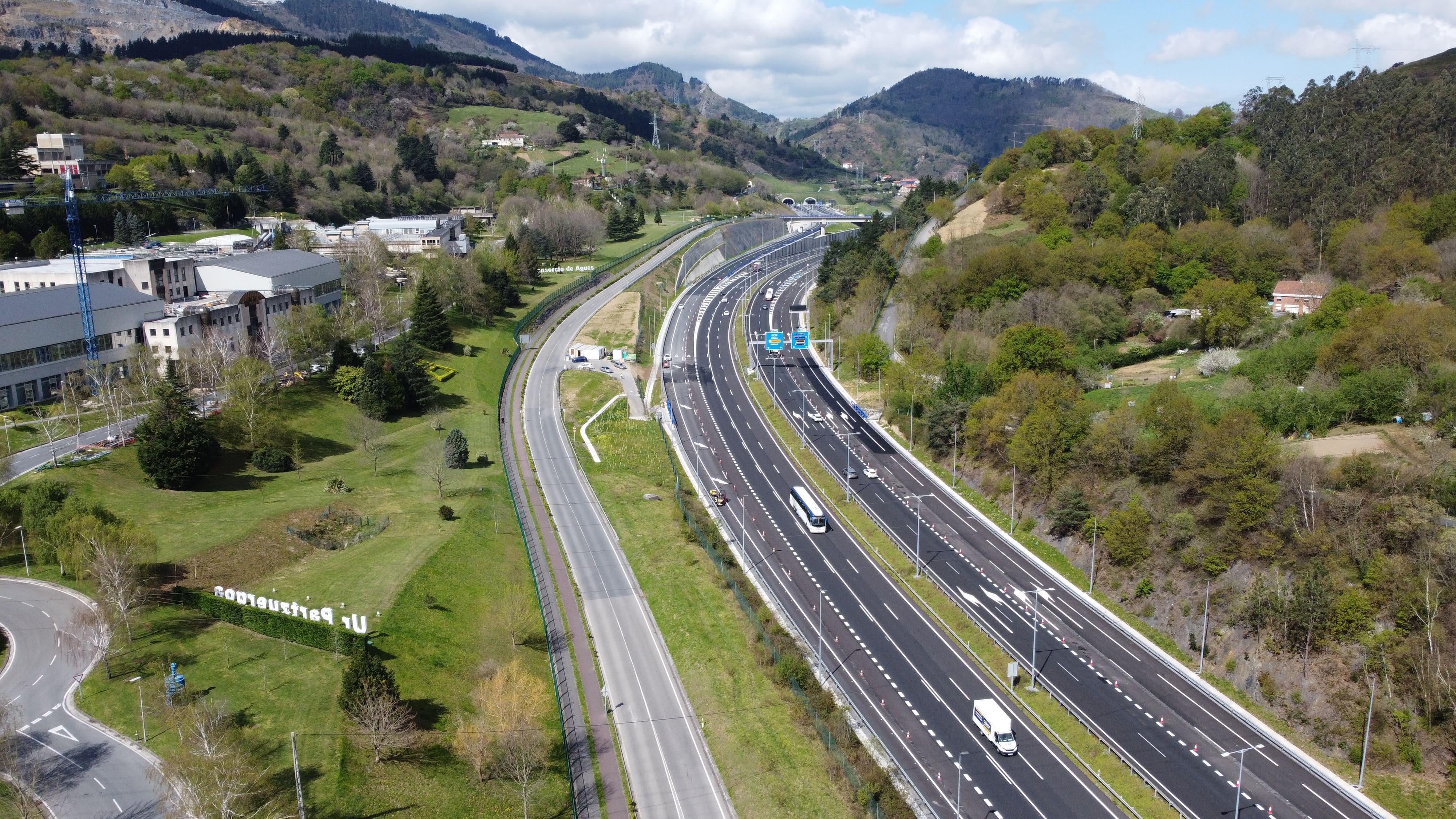
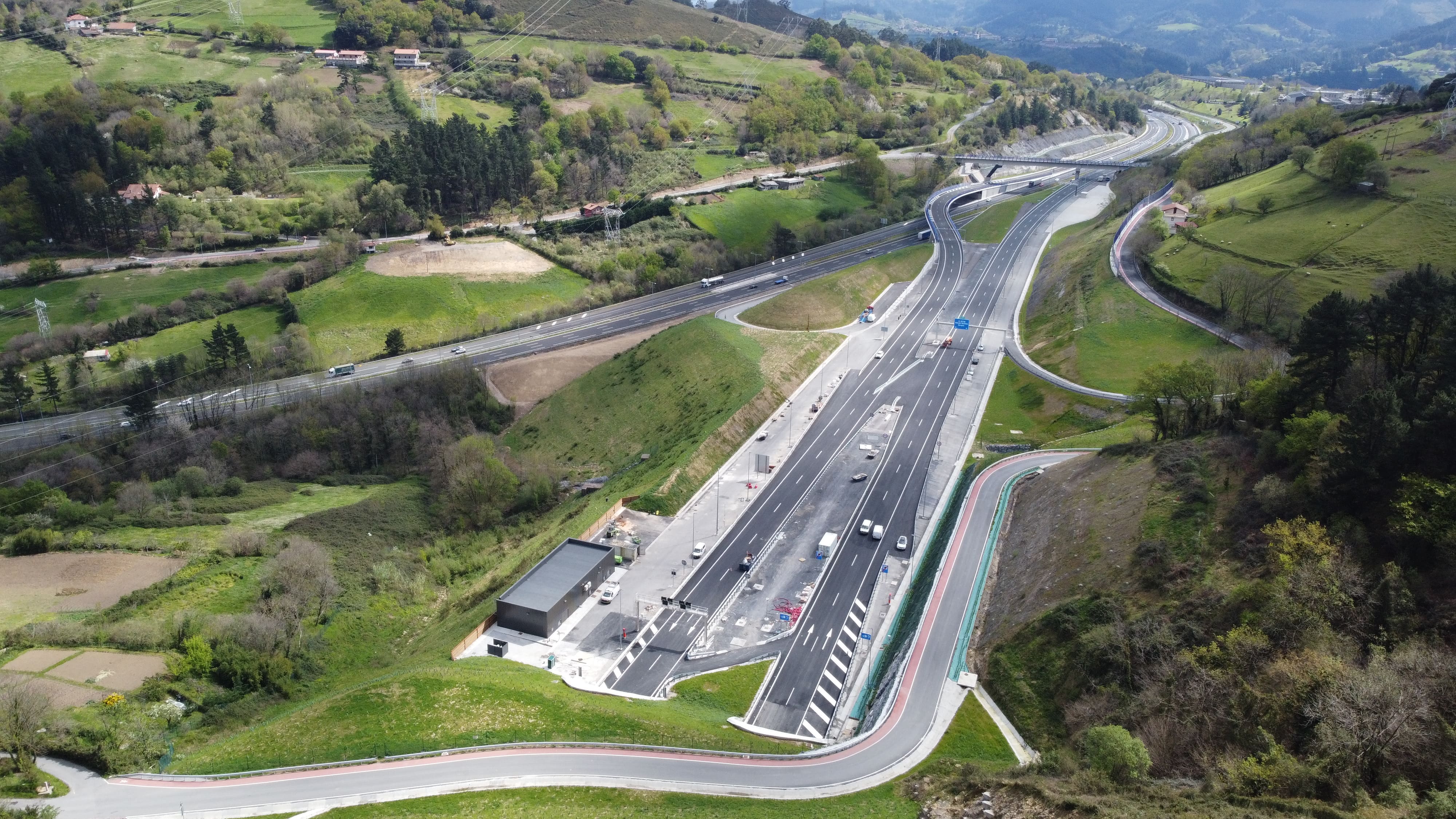

Arnotegi Tunnels
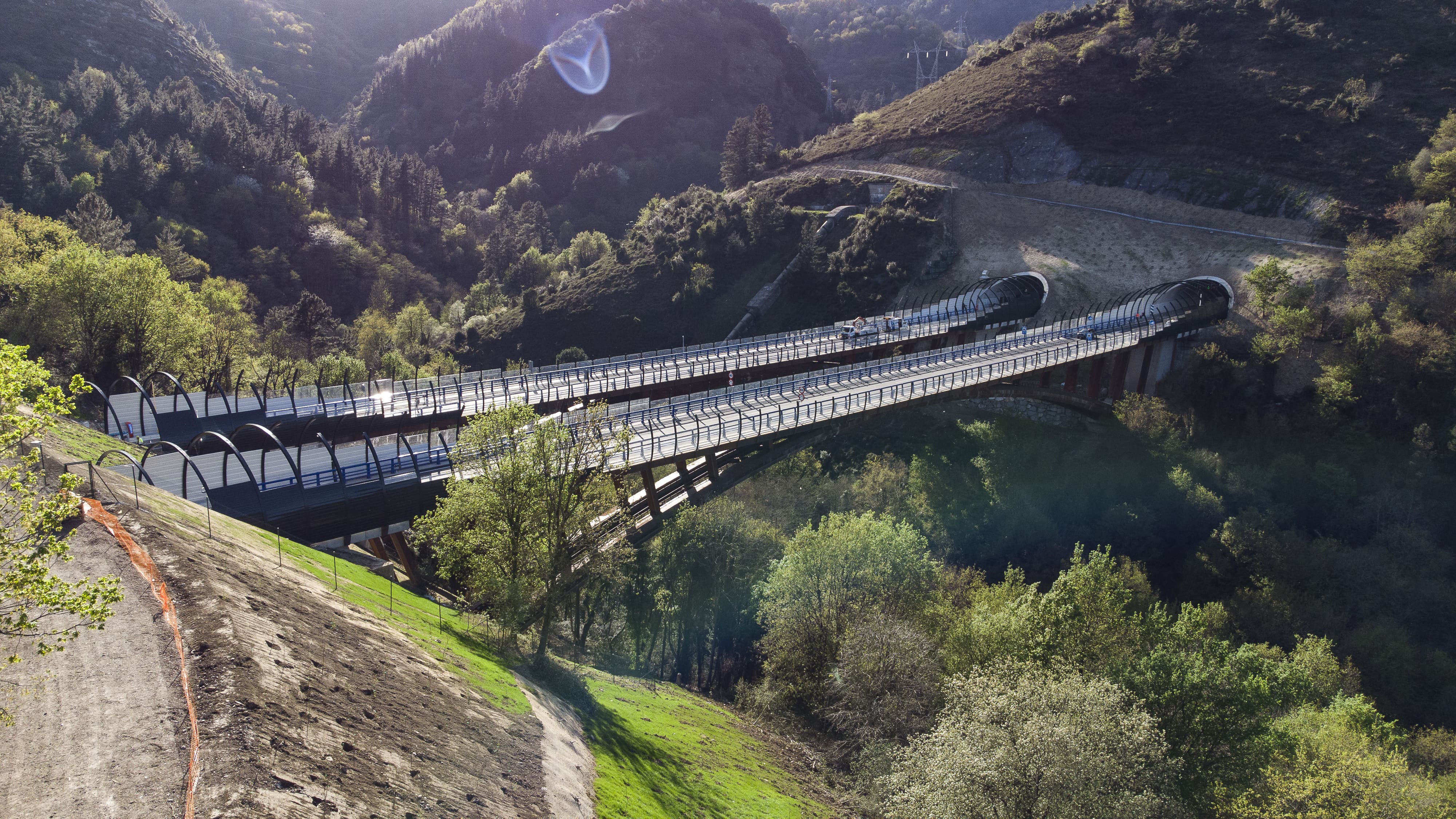
Bolintxu
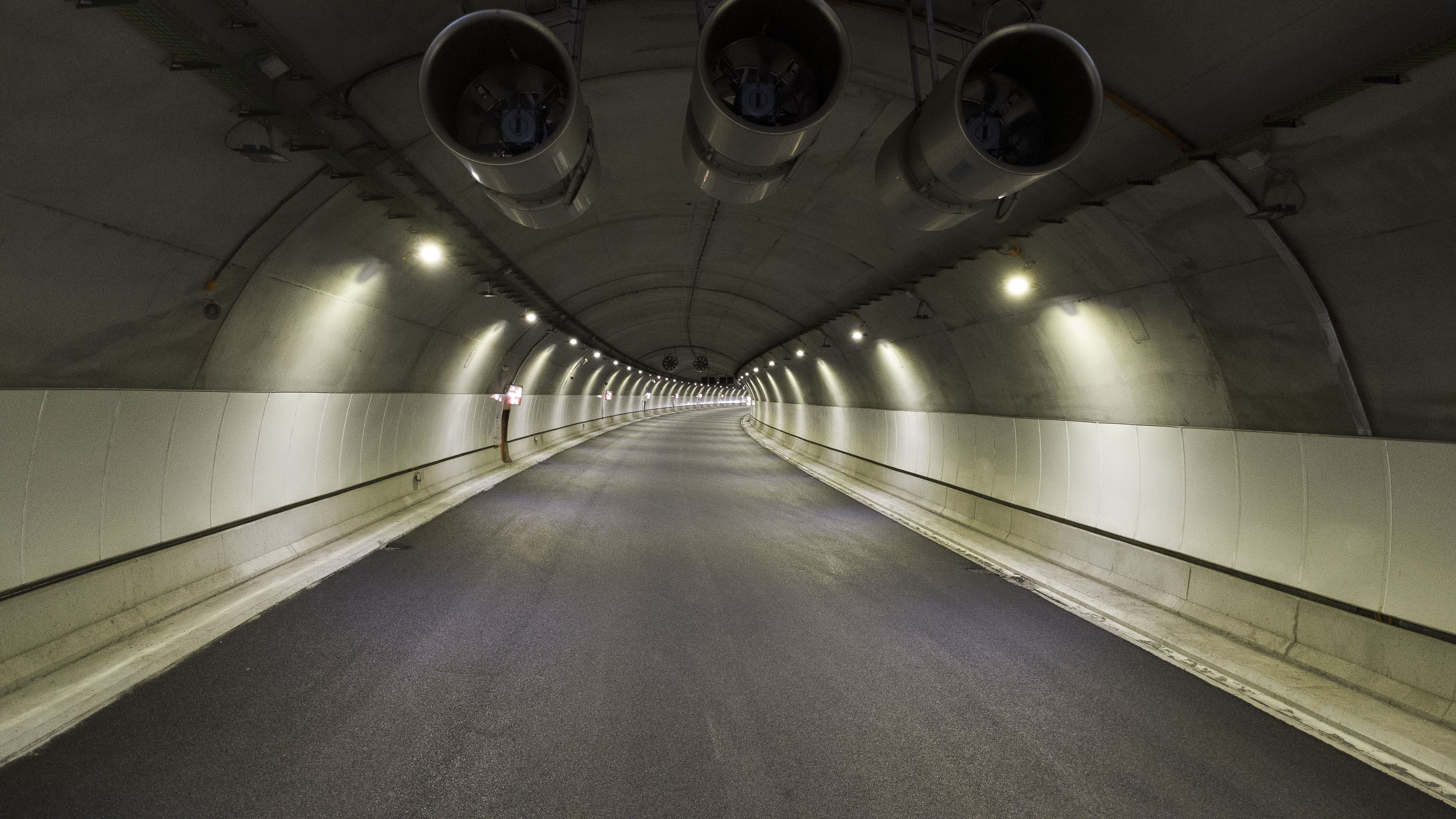
Interior del tunel
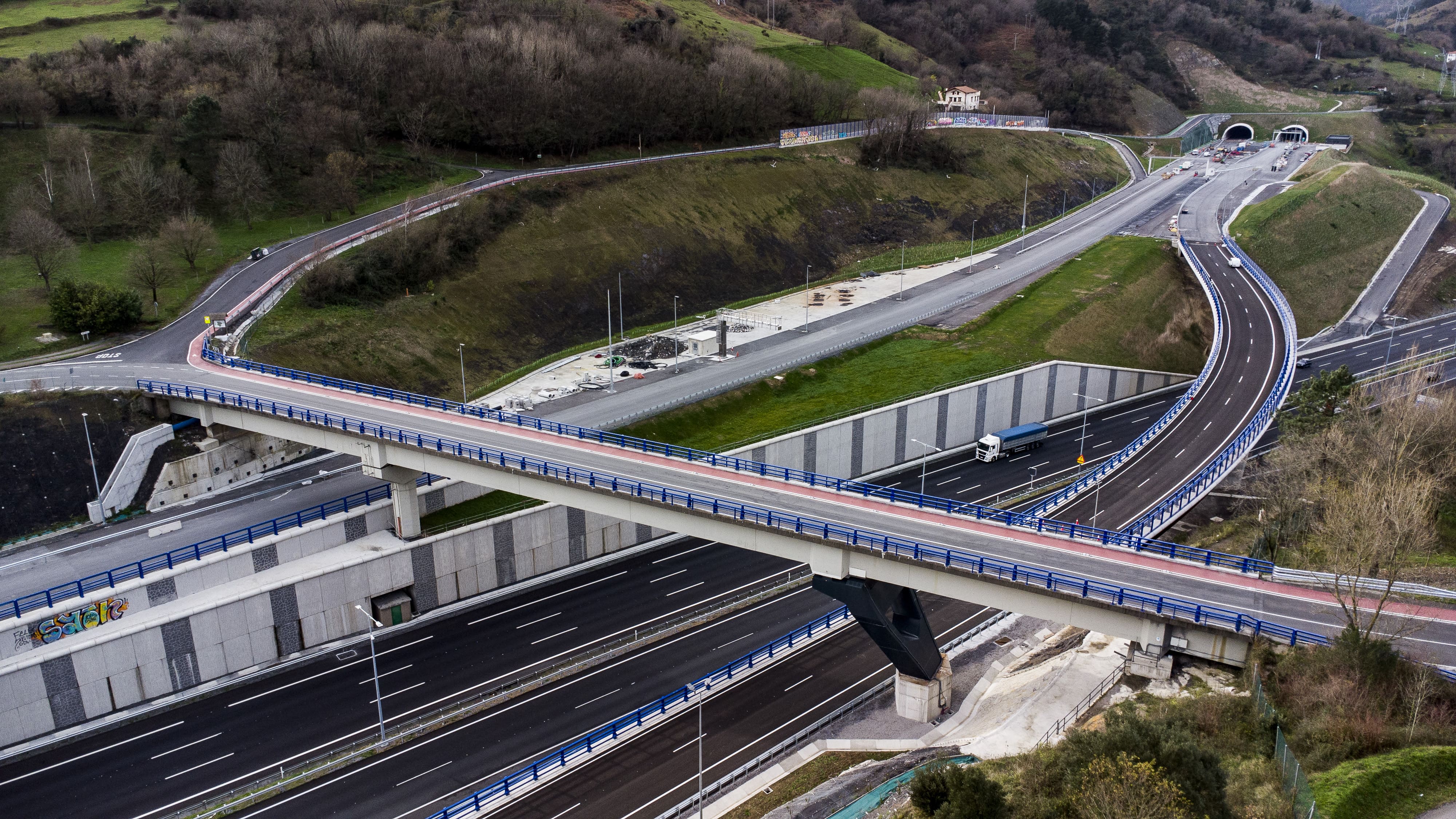
Viaducto
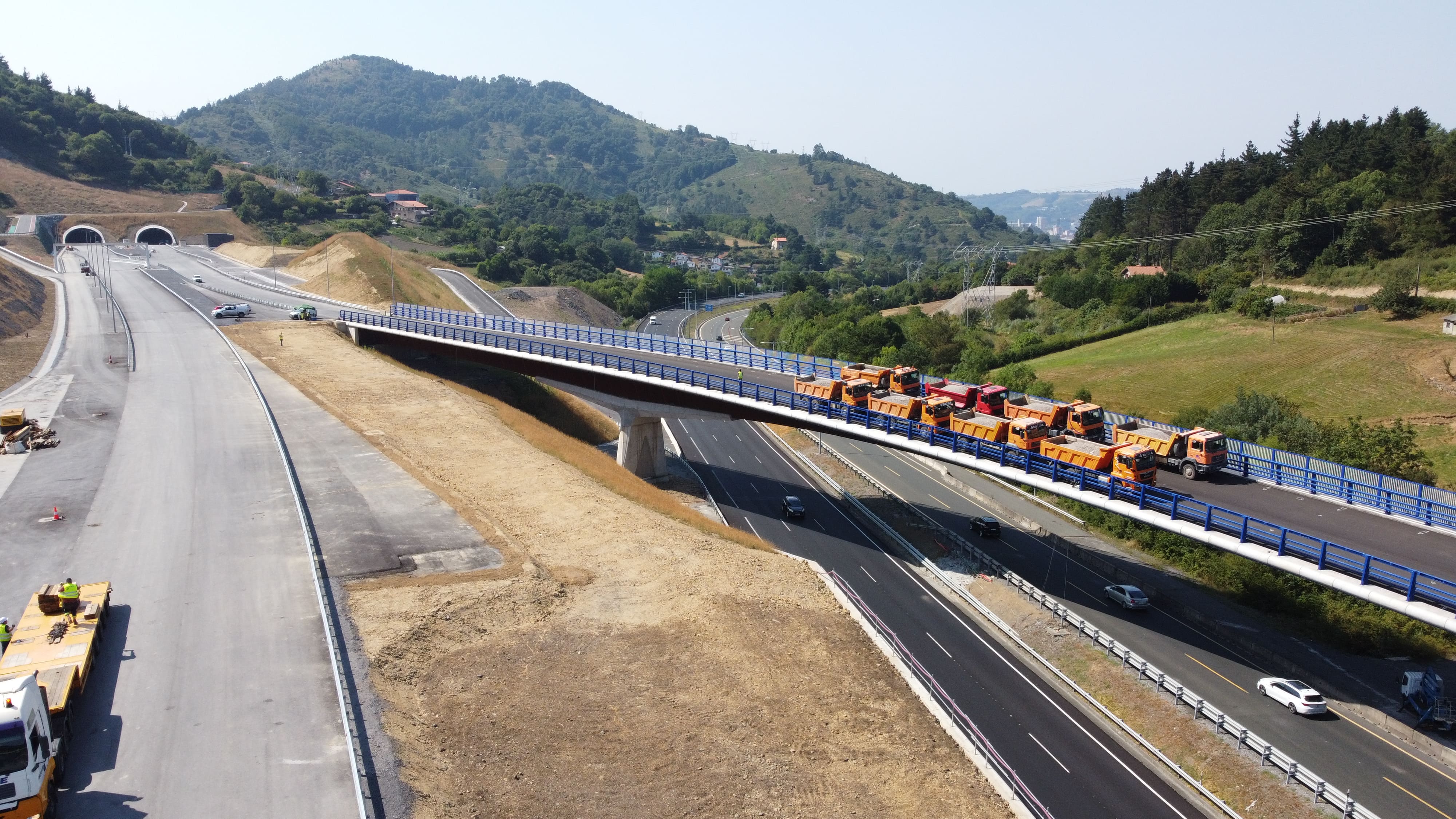
In construction
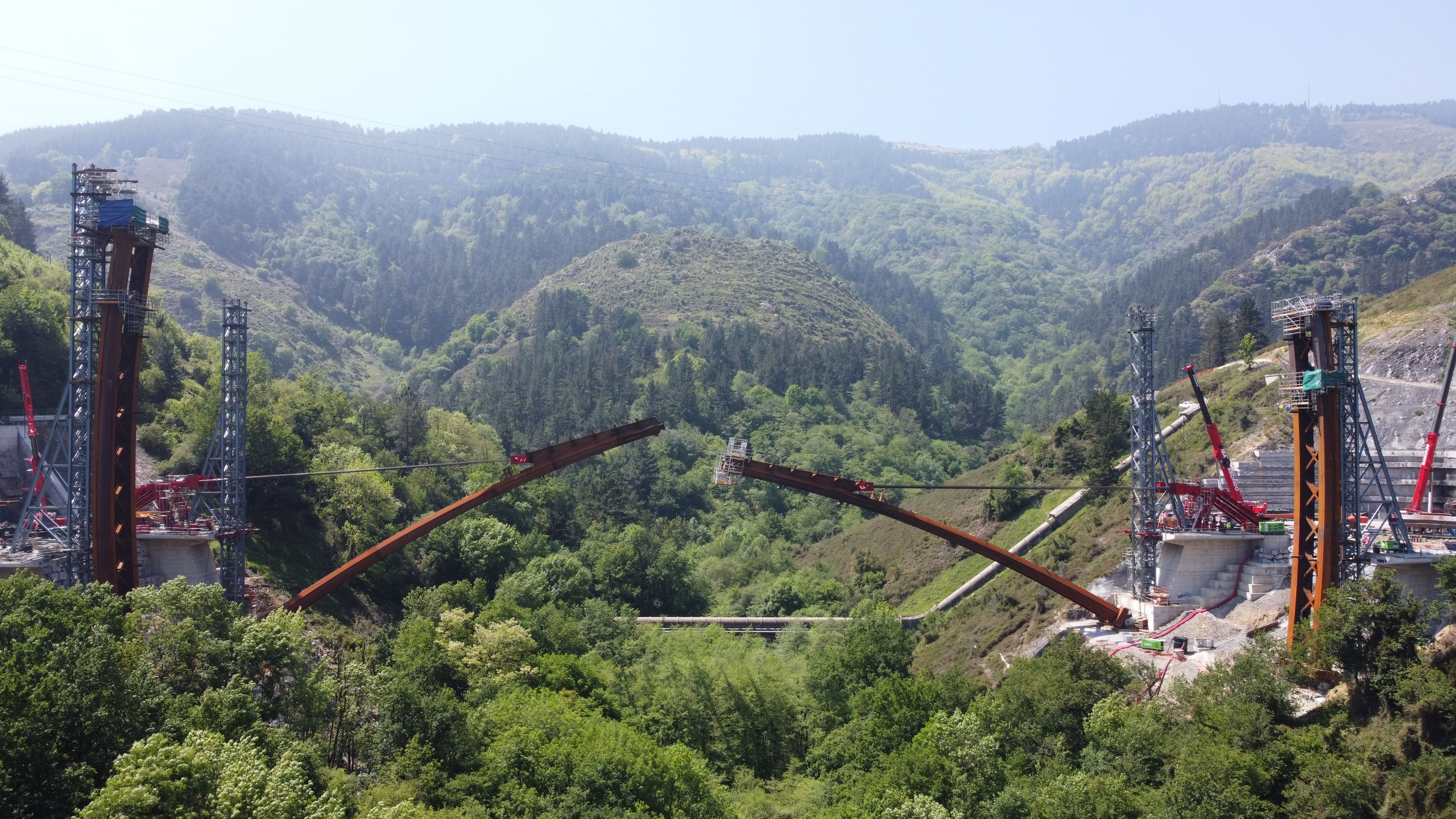
In construction
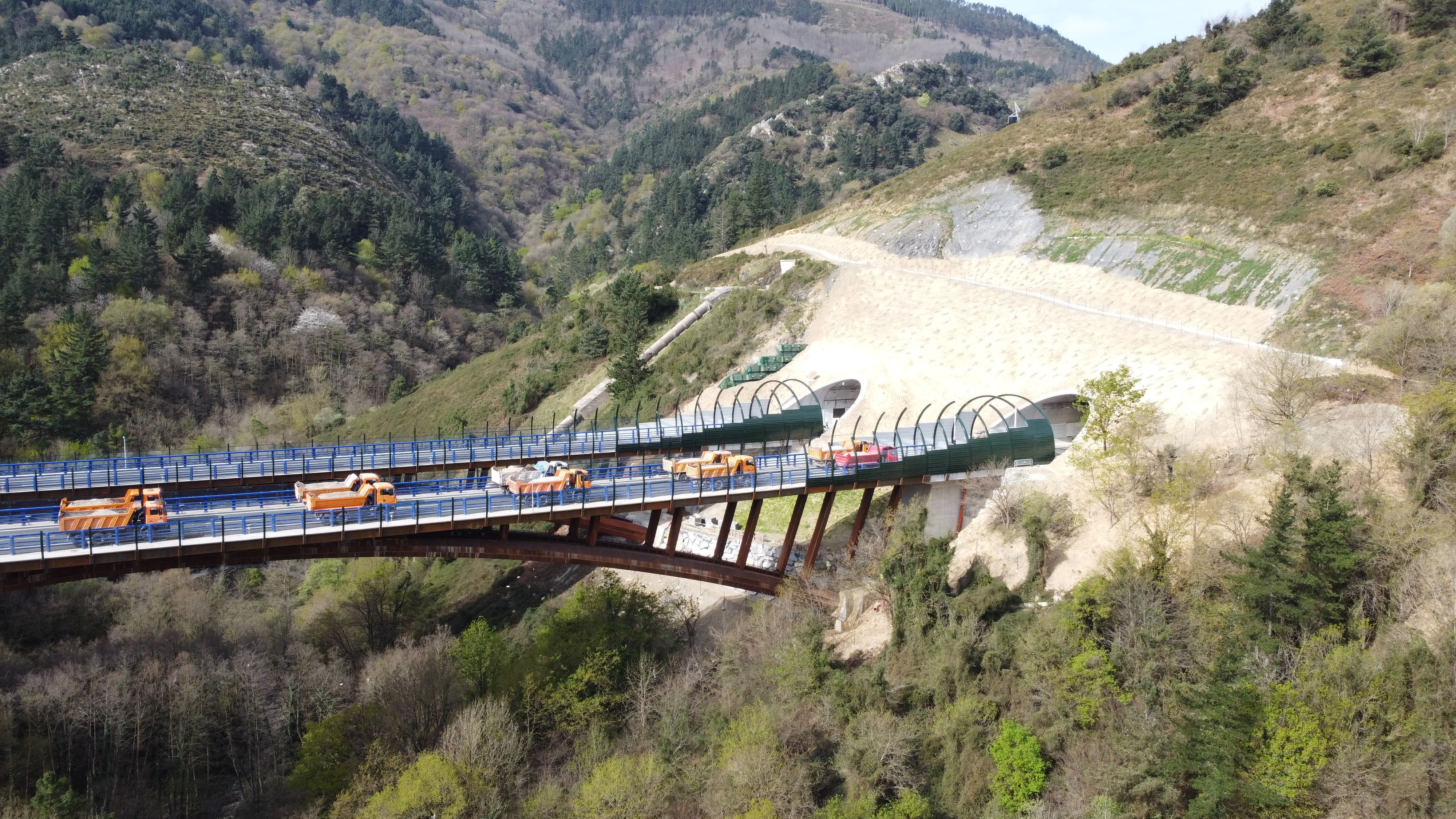
In construction
The video begins with an aerial view with two different perspectives of the excavation work on both sides of the AP-68 motorway, showing different machines working in the area. The first scenes show signs over the motorway that read Pagabidea Viaduct and VSM (South Metropolitan Bypass).
Two red self-propelled cranes can be seen placing prefabricated concrete panels on the sides of the AP-68 motorway with cars and lorries driving along it.
Rapid sequence of images of the construction of the abutments and piers of the viaduct over the AP-68, the filling of earth over one of the abutments and the placement of prefabricated concrete panels forming a wall along the side of the AP-68 motorway.
Worker welding on one of the wings of the metal structure that will form the viaduct.
Sequence of night-time images of the assembly of the first section that will form the deck of the viaduct over the motorway.
View from a drone, showing two yellow self-propelled cranes, with many operators in the vicinity giving instructions for the assembly of the section.
Advancing of the section towards the pier for securing and two orange lifting baskets with operators for the adjustment.
Daytime aerial image of the placement of the first section of the viaduct and view of the vegetation that is beginning to spring up in the land fills.
View of the first section of the pier that will replace the existing one on the viaduct that crosses the AP-68 motorway, showing the shoring of the concrete formwork and the start of the metal structure.
New drone view of the section placed on the pier, with the next section to be connected to it and the progress with the prefabricated wall.
Sequence of images of the raising and hoisting by two yellow cranes of the second section of the viaduct over the AP-68.
Aerial view of the adjustment between sections with several workers and two lifting baskets with the welders who will join the sections together.
New drone view of the two sections in place.
Aerial sequence of the lifting and adjustment of the third section of the piece of concrete that supports one of the sections on the abutment.
View of an operator in the basket for the adjustment between sections.
Drone image of the third section in place and the progress of the earth filling and the prefabricated wall.
Image of the finished concreting of the pier connection and the metal section above.
Surveyor checking measurements for adjustment of the metal caissons of the viaduct over the AP-68.
Aerial drone view of the progress of the earth fills with the tracks and metal structures.
Night-time image of the transporting of the fourth section of the viaduct over the AP-68 on an articulated lorry with many wheels that rotate controlled by an operator holding a remote control in his hands.
Anchoring and lifting of the fourth section to place it in its final position.
Rotating shot of the section suspended by the two cranes before it is put in place.
Bringing the section between the abutment and a temporary support.
Workers adjusting the section to the abutment.
A worker hammers a plate for the adjustment.
Image of the attachment of the slings and the start of the lifting of the fifth section of the viaduct.
Sequence of speeded up images of the lifting and adjustment of the fifth section, which is attached to the caisson of the fourth section and supported on the other pier.
Sequence shot from the base of the pier connection to the part that will be supported under the existing deck.
Moving image of the progress of the pier connection with perimeter scaffolding and the support on the existing viaduct, as well as the aerial view of the progress of the metal deck over the AP-68 motorway.
Aerial view of two white cranes in front of a pier of the viaduct that crosses the motorway in order to remove it.
Pulley and cable equipment cutting through the existing concrete pier by friction.
Removal of the upper section of the previously cut pier with the self-propelled cranes.
Image of the lowering of the upper section of the pier onto a lorry on two metal supports to take it to the demolition site.
Night-time aerial view of two yellow cranes hooking up the sixth section of the viaduct over the AP-68 motorway.
Lifting, positioning and adjustment of the sixth section of the viaduct over the AP-68 motorway.
Daytime aerial view of the assembly of all the caissons forming the viaduct over the AP-68.
Red self-propelled crane loading a large slab and supporting it on the metal caisson forming the viaduct over the AP-68.
Top view of the deck with different workers placing steel rods on the concrete slabs.
Workers placing hydraulic jacks on the pier connection supports.
Aerial view of the entire metal structure of the viaduct over the AP-68 and the placement of concrete slabs at the ends of the viaduct. A backhoe excavator can also be seen working along with a dumper truck that is approaching it.
Sequence of speeded up shots of the workers assembling all the reinforcement and concreting on the deck of the viaduct over the AP-68.
White and yellow articulated lorry loaded with a large brown metal part crossing over the new viaduct over the AP-68.
Several workers placing steel rods at the ends of the bridge deck to fit the retaining systems.
Two workers smoothing the concrete of a pavement over prefabricated walls.
Time-lapse images of the placement of the blue metallic containment systems and acrylic acoustic screens of the same colour on the sides of the deck of the viaduct over the AP-68.
Images of the finishing of the acoustic screens and a view of an excavator finishing the filling of the viaduct abutment.
The video ends with a recording from inside a car driving along the motorway showing the finished result from the underside of the viaduct over the AP-68.
The video begins by showing a section of road with three-lanes in the same direction belonging to the AP-68 motorway.
We see an elevated bridge crossing the motorway transversally.
The first gantry sign is displayed indicating that 1000 m away is exit “1B” from the AP-8, and showing the directions that can be taken: the sign on the left indicates Bilbao, “aireportua” (airport) and Barakaldo on the AP-68 E-804; the sign on the right indicates Balmaseda, Santurtzi, “portua” (port) and Santander on the AP-8 E-70; and the sign in the middle is a mixture of the above so that the user can choose the appropriate destination.
A gentle bend to the left can be seen with directional panels and signs indicating the creation of a new lane from the central lane, with the result that there are four lanes.
We see a sign showing a speed limit of 100 km/h and a lateral sign indicating the prohibition of heavy vehicles on the A-8 motorway, indicating the obligation to take exit 1B, which corresponds to the AP-8.
Gantry sign informing drivers that the exit is 500 m away with the reiteration of the previous signage, with white arrows on the road surface to facilitate driving for users.
We see signs informing drivers taking the AP-68 that there is a clearance control with a maximum height of 5 metres.
Physical appearance of the fourth lane in the centre of the road with a wider broken line, reinforcing the signage with arrows painted on the asphalt and a vertical sign with four arrows indicating the direction of traffic at the side of the road.
The white arrows on the road are repeated on two occasions so that drivers take the exit corresponding to their destination.
Another gantry appears with the same indications as the previous ones, indicating that the exit is imminent and limiting the distance for the merging of vehicles.
At the right-hand side of the road there is a variable-message (matrix) sign which is switched off.
Along the axis of the carriageways there is cross hatching with white lines with blue and white road delineator posts.
We are now entering the access road to the AP-8 South Metropolitan Bypass with two lanes in each direction.
Sequence of speed limit signs, first 80k/h and then after 150 m a 70km/h sign with a triangular sign at the top indicating a bend to the left.
Viaduct elevated above the road crossing it transversally, with a singular grey pier deviating from the vertical from its point of support.
Entrance to the viaduct with a bend to the left that crosses over the AP-68 motorway, with robust containment systems in Bilbao blue and transparent acoustic screens.
Halfway along the viaduct, there is a reverse curve to the right, at the end of which there is a traffic light gantry with a green light, and at the bottom of the gantry there are red and white bands indicating the maximum clearance.
Reiteration of information signs for a dual carriageway.
Raised white barriers appear on the sides of the road, with an unlit lateral clearance sign.
Sign prohibiting overtaking by lorries.
The mouth of a tunnel can be seen in the background.
Information sign on the right-hand side indicating the safety systems of the Seberetxe tunnel. Length of 624 metres, emergency exits every 300 metres, equipped fire hydrants every 50 metres and SOS posts every 100 metres. In it, we also see signs indicating a speed limit of 80 km/h and a safety distance of 100 m between vehicles.
A little before entering the tunnel, there is a gantry with illuminated lane control cross-arrow signals and maximum speed depending on the status of the tunnel. On the sides of the road, we see reminder signs to turn on the lights, side panels and blue and white posts.
The sides are lined with white vitrified steel panels up to a height of 2 metres.
The right-hand hard shoulder is 4 metres long and has cross hatching with white lines with blue and white plastic posts.
We see another section with three fans above the road, and on the right side wall an orange door indicating the SOS post and equipped fire hydrant. There are backlit signs indicating these.
The sequence of SOS posts and equipped fire hydrants is repeated.
The first emergency gallery labelled “G1” appears and is illuminated by green LED lights. In this same section, in the upper part of the tunnel, a structure with four rectangular speed limit and cross-arrow signals is visible.
There are repeated views of safety elements inside the tunnel in different sections, ventilation in the upper part of the tunnel, SOS posts and equipped fire hydrants on the sides of the tunnel.
A brightening of the light indicates the end of the Seberetxe tunnel.
As soon as we come out of the tunnel, we can see a transition between the concrete and the Bolintxu viaduct with sections of metal profiles with sound-absorbing panels to minimise the noise coming out of the tunnel.
Information sign showing that the Bolintxu viaduct is 161 metres long.
Crossing the viaduct, on both sides, there are metal safety systems and, further out, acrylic acoustic screens.
We see a repetition of signs with a speed limit of 80 km/h and a safety distance of 100 m between vehicles.
End of the Bolintxu viaduct and entrance to the Arnótegi tunnel.
At the entrance to the Arnótegi tunnel, there are various information signs showing that it is 1,947 metres long and lights should be switched on, side beacons and two arrows painted on the ground.
At the entrance there is a widened section for safety with two barriers on both sides in case the tunnel has to be closed, SOS posts and a fire hydrant, protected by a metal safety barrier with an opening to allow the entry of emergency vehicles.
As soon as we enter the tunnel, it is illuminated with lights on the upper part of both side walls, and from the apex of the tunnel hangs a structure with illuminated lane control cross-arrow and speed limit panels. The cross-section of this tunnel is slightly smaller, with the right-hand hard shoulder being 2.5 m wide.
Ventilation sections with three fans and the same sequence of safety systems as the Seberetxe tunnel.
Second emergency exit “G2” illuminated like all the others with green LED lights.
Shortly before the “G3” gallery, there is another section with cross-arrow and speed limit signs.
In gallery “G4”, the tunnel cross-section becomes larger to allow emergency vehicles to pass through. A shock absorber is fitted at the transition from the widened section to the normal tunnel.
Level with gallery “G5”, a variable-message panel, which is switched off, hangs from the apex.
In gallery “G6”, it appears that the layout follows a smooth curve to the left.
In gallery “G7”, there is also a widened section for the passage of emergency vehicles.
Gallery “G8” is visible and in the upper part there is also a variable-message sign that is switched off.
A little before gallery “G9”, there is a brightening of the light indicating that the end of the tunnel is near.
Just outside the tunnel, there are information signs reminding drivers to switch off the lights and the 80 km/h speed limit.
At the top of the image, a concrete viaduct crosses the roadway.
On the right-hand side, there is a grey building with a white screen-printed oak leaf logo with the words Bizkaia in bold letters and, in finer letters in the lower part, Interbiak.
There is white cross hatching with information signs indicating that a road will converge from the right-hand side a little further on.
The two roads converge with the help of signalling in the form of white lines, the central one being a thicker, broken line.
A switched off variable-message sign on a gantry can be seen and on the side of the road the information sign indicates that the Peñaskal viaduct has a length of 181 m and a speed limit sign of 100 km/h.
In the background of the image, the entrance to the Arráiz tunnel can be seen.
The video begins with the view of a three-lane road inside the Arráiz tunnel corresponding to the AP-8 motorway.
View of the “G12” emergency gallery and in the background a section of illuminated lane control cross-arrow and speed limit signs hanging from the tunnel ceiling.
On the left, the “G11” emergency gallery can be seen, and in the background at the top, an illuminated warning sign for the next fork in the road.
On the left, the “G10” gallery is visible and in the background a brightening of the light indicates the tunnel exit with two sections where three fans are operating.
As soon as we come out of the tunnel we see an information sign for the 195 m long Peñaskal viaduct with traffic signs indicating that the three lanes become four lanes, two in each direction.
Gantry with two information signs, the one on the left indicating the AP-68 E-804 Vitoria-Gasteiz and Burgos with two lanes in each direction and the one on the right A-8 E-70 Donostia-San Sebastian and Bilbao via Miribilla.
View of a gantry with a switched off variable-message sign and behind it a viaduct which crosses above the motorway.
Entrance to the Arnotegi tunnel with the information sign indicating that it is 1,947m long and the safety systems inside it, as well as the signs showing the 80 km/h speed limit and safety distance between vehicles.
The tunnel is illuminated by two rows of LED spotlights at the top of the side walls, and all the emergency system signs can be seen in the tunnel.
“G9” emergency gallery, section with three fans and illuminated signs with green arrows and 80 km/h speed limit.
As we advance, there is a gentle bend to the right where we can see the emergency galleries “G8” and “G7” and a repetition of illuminated signs for the different safety elements available in the tunnel.
The bend to the right continues until the emergency gallery “G6” where it becomes a straight line and the brightening of the light of the tunnel exit can be seen.
In the “G4” gallery, there is a widened section on the right-hand side to allow emergency vehicles to turn.
Close to the tunnel exit, on the left we can see the exit “G2” with two sections with fans and in the background some signs with a green arrow and a red arrow with a speed limit of 80 km/h.
As soon as we leave the tunnel, we can see the transition from the concrete tunnel mouth to the Bolintxu viaduct made up of green metal trusses, supporting transparent acrylic acoustic screens, which gradually descend to the centre of the viaduct, where they then rise again to the next tunnel, called Seberetxe.
The information signs for the 142 m Bolintxu viaduct appear and in the background we see the entrance to the Seberetxe tunnel.
As soon as we enter the Seberetxe tunnel, it is illuminated by the overhead signs with green arrows and a red sign indicating the speed limit of 80 km/h.
The road is two lanes in each direction with a wide hard shoulder with white stripes on the asphalt and cylindrical blue and white plastic posts delineating the road.
As the video progresses, there is a very gentle bend to the left.
Halfway round the bend, the emergency gallery “G1” can be seen on the left side wall and the tunnel exit begins to come into view.
Coming out of the tunnel, we can see the signs reminding drivers to switch off the lights, the end of tunnel and a reminder of the 80km/h speed limit.
In the following image, we can see a gantry with a fixed information sign for the AP-68 E-804 Vitoria-Gasteiz and Burgos motorway with two arrows at the bottom indicating the lanes of the road.
There is a gentle bend to the right with a gantry with number plate reading cameras, and in the background a viaduct that crosses the road and the AP-68 motorway can be seen.
On the left-hand side, the AP-68 motorway comes into view, with signs indicating that the road is going to join it.
Cars and lorries can be seen driving along the AP-68 motorway, which we are about to join, with the give way signs and the broken lines painted on the road and the arrows indicating the reduction from two lanes to one.
The vehicle smoothly merges onto the AP-68 motorway, giving way to vehicles coming from the left.
The final view is the end of the merging lane and the three lanes of the A-68 motorway with the vertical motorway signs and the three arrows indicating the number of lanes.
The Bizkaia sign appears next to the text: "Lowering of the Bolintxu viaduct".
View of the Bolintxu valley with all its vegetation and in the background the entrance to the Arnotegi tunnels and in the foreground the half-arches of the viaduct in ochre, raised and braced by the grey auxiliary towers.
A self-propelled crane lifts a large piece of the half-arch.
The assembly of the piece in the last section can be seen.
Aerial view of the half-arches being lifted into the sky, with the tunnel port in the lower plane.
2 operators pulling steel cables towards a red hydraulic jack.
View from the mouth of a tunnel of the hoisted arches, the grey auxiliary tower and a self-propelled crane.
Aerial view of one of the half-arches, attached with a cable harness for lowering, attached to the auxiliary tower and accompanied by a self-propelled crane.
View of the valley with all its vegetation with the half-arches hoisted at both ends ready to be lowered.
Operator on top of one of the half-arches with the valley covered in fog in the background.
Jack pressing on one of the half-arches to start the lowering manoeuvre.
View of the hoisted half-arch starting the lowering manoeuvre held by the cable harness and moving away from the auxiliary tower that held it until then.
View from below of the cable harness holding the half-arches.
View of the half-arches being lowered from the base.
View of the half-arches from one end of the valley as they are lowered.
View of the hinge from the other end.
View of the swivel from which the half-arms pivot.
Another view of the folding from one end, but with the half-arches forming 45º with the horizontal.
View of the half-arches almost collapsed and about to join at the keystone.
A new view of the half-arches coming down with the tunnel mouth in the background.
Close-up of the half-arches coming together at the keystone.
Aerial view from the top of the valley with the half-arches already together and completing the arch of the new bridge, still attached to the cables at the ends and with the green background of all the vegetation of the Bolintxu valley.
The Bizkaia Egiten sign comes out.











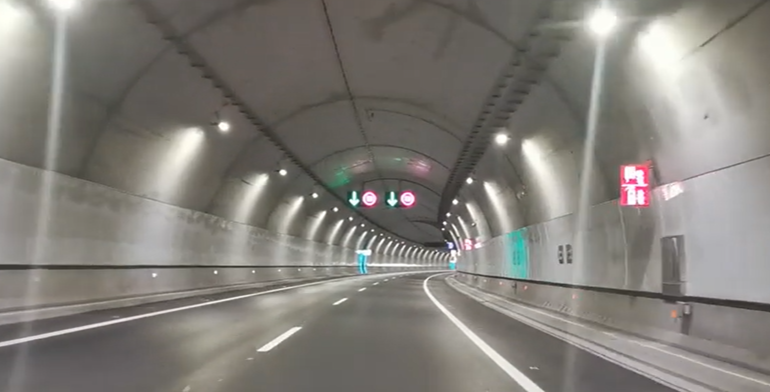
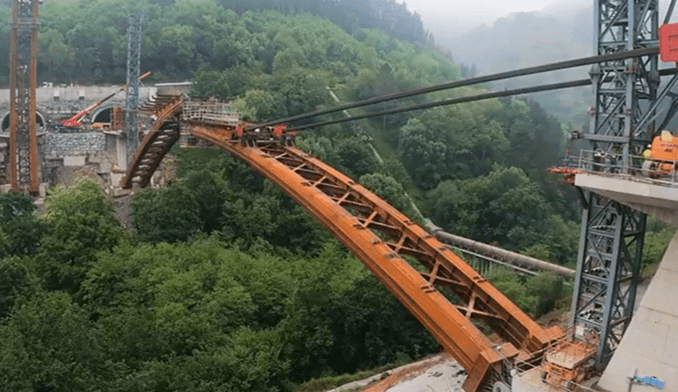
Phase 1 of the Southern Metropolitan Bypass (VSM) begins in Santurtzi (past the Ugadelbieta service area) and reaches Venta Alta (Arrigorriaga). It is divided into two sub-phases::
- Phase 1a, between Santurtzi and Larraskitu, began in May 2007 and has been in service since September 2011.
- Phase 1b: from Peñascal to Venta Alta, started in January 2019, and entered into service in spring 2023.
Phase 1b characteristics
Phase 1b consists of the connection of the Southern Metropolitan Bypass VSM from the Peñascal junction to the AP-68 motorway at Venta Alta. Its implementation fulfils the main objective of Phase 1: The creation of a functional and safe road alternative to the most congested section of the A-8 motorway, which is the section between the Port link and the AP-68 motorway. The general objectives of the Bizkaia Road Plan are also achieved.
- To optimise the functioning of the Metropolitan Road Network.
- To respect the environment and nature at a level that ensures that ensure quality of life by reducing congestion times and pollution and noise levels.
- To reduce the accident rate by eliminating accident hot spots.
- And to provide a new approach for demand management and traffic control.
The work has been divided into two sections:
The first is Section 9A, Peñascal-Bolintxu. The second is Section 9B, Bolintxu-Venta Alta, which in turn is subdivided into two subsections:
- Subsection 9B-1, Bolintxu-Venta Alta junction
- Subsection 9B-2, Seberetxe Tunnel
Section 9a Peñaskal-Bolintxu runs entirely within the municipality of Bilbao. It essentially consists of the trunk road of the Southern Metropolitan Bypass between the adjoining sections 8a, Peñaskal-Larraskitu (already in service), and 9b, Bolintxu-Venta Alta (under construction).
It starts at the Peñascal junction and continues inside the cut-and-cover tunnels built under the area where vehicles leaving the VSM in the direction of the A-8 via the Larraskitu tunnels are charged a fee. From the cut-and-cover tunnels, the excavation and support of the Arnotegi tunnels has been carried out until reaching the Bolintxu valley, where the section ends.
The total length of the section is 2,180 metres. The standard section of the trunk road is two (2) lanes in each direction, each 3.5 metres wide.
The entire section runs virtually inside the Arnotegi tunnels, with the length of the underground carriageway (including the cut-and-cover tunnels already built) being 1,916 and 1,933 metres for each tube.
The execution of the works has generated a total cuttings volume of 513,132 m3, and a total embankment volume of 33,013 m3, which has meant the need for 527,800 m3 of surplus disposal volume. This surplus material has been taken to the Peñaskal surplus site, a former quarry that was partially filled during the works of phase 1a.
In the Bolintxu area, all the work has been influenced by the environmental importance of the surroundings. In this regard, the opening at Bolintxu has been resolved with several anchored micro-pile screens (front and side) to minimise the volume to be dug in this unique spot.
ARNOTEGI TUNNEL
The Arnotegi tunnels have been built with the following geometric characteristics:
- Standard section: two pavements of 0.75 m + 1.00 m hard shoulder + two lanes of 3.50 m + 2.50 m hard shoulder.
- eight galleries between tunnels, of which six are pedestrian galleries and two are vehicle galleries with lateral lay-bys.
The total lengths of the tunnels, including cut-and-cover tunnels and tunnels in mines, are 1,916 m for Axis-1 and 1,933 m for Axis-2.
PEÑASCAL JUNCTION
The Peñascal junction connects the VSM with the A-8 motorway and with the Miribilla junction through the Larraskitu tunnels. The works have included its refurbishment, adapting its drainage networks and channelling, as well as its surfacing, signposting, and lighting. All open areas have been finished off with appropriate re-vegetation and environmental restoration work.
Vegetation restoration and landscape integration measures have been carried out on all areas affected by the works. It is particularly worth mentioning the recovery and morphological restoration of the Peñaskal quarry, where the planting of species typical of the oak wood and the restoration of the surrounding waterways with riverside species will make it possible to re-establish the previously existing habitats and ecological connectivity, enhancing the biodiversity of the surroundings.
Cookies
We use proprietary and third-party cookies for analytical and customisation purposes, such as choosing the language in which to display the website. For more information, please consult our Cookies policy (Opens modal window). You can accept all cookies by clicking “Accept” or configure/reject the use of cookies configure (Opens modal window: Configure cookies).
Cookies policy
The website at https://interbiak.bizkaia.eus (hereinafter, the "Website") uses tools to track browsing activity on the website and the IP address of the service recipient for the purpose of improving and guaranteeing the provision of services or technical operation of the website, distinguishing you from other users and analysing your browsing habits.
This Cookies Policy seeks to inform you clearly and precisely about the operation and function of the cookies we use.
What are cookies and why do we use them?
A cookie is a file that is downloaded to your computer when accessing certain websites.
Cookies enable a website to, among other things, store and recover information about the browsing habits of a user or their device and, depending on the information contained and the way in which the same is used by the device, may be used to recognise the user.
Current law allows us to store cookies on your device if they are strictly necessary for operation of this website. However, we need permission for all other cookies.
Types of cookies based on the managing entity
p>Depending on who manages the computer or domain from where the cookies are sent and who processes the data obtained, a distinction can be made between the following types of cookies:
- Proprietary cookies: these are managed by the Provincial Council of Biscay.
- Third-party cookies: these are managed by another entity, which processes the data obtained via the cookies. This website uses cookies from Google Analytics: a web analytics service developed by Google that allows website browsing to be measured and analysed. You will see cookies from this service in your browser. More information can be found here: more information about the types of cookies used by Google.
Types of cookies based on their purpose
- Technical cookies: these allow the user to browse a website, platform or application and to use the various options or services available, such as control data traffic and communication, identify the session, access restricted areas, request registration or participation in an event, use security elements while browsing, store content for video or audio playback, or share content via social media networks.
- Customisation cookies: these allow the user to access the service with some general characteristics predefined according to a series of criteria on the user’s device, such as the language, type of browser being used to access the service, regional configuration from where the service is accessed, etc.
- Analysis cookies: these allow the number of users to be counted and the browsing activity to be statistically measured and analysed for the purpose of improving the services made available. They may be proprietary or third-party cookies.
Duration of the cookies
- Session cookies: these collect and store data while the user is visiting a website.
- Persistent cookies: the data are stored on the device in an ongoing fashion and may be accessed and processed during a period defined by the cookie manager, which may range from a few minutes to several years.
Which cookies does this website use?
Type of cookies in https://interbiak.bizkaia.eus Pendiente texto descriptivo
| Name | Type | Purpose | Duration | Owner |
|---|---|---|---|---|
| JSESSIONID | Technical | Session Identifier | Session | Provincial Council Of Biscay |
| ASPSESSIONID | Technical | Session Identifier | Session | Provincial Council Of Biscay |
| TS01 | Technical | Session Identifier | Sesion | Provincial Council Of Biscay |
| LFR_SESSION_STATE | Technical | Session Identifier | Session | Provincial Council Of Biscay |
| COOKIE_SUPPORT | Technical | Indicate whether the user has the cookie support activated | 1 year | Provincial Council Of Biscay |
| pc_tecnicas_interbiak | Technical | Choose Your Preferences For Acceptance Of The Block Of Technical Cookies | 1 year | Provincial Council Of Biscay |
| pc_analitica_interbiak | Technical | Choose Your Preferences For Acceptance/Rejection Of The Block Of Analytical Cookies | 1 year | Provincial Council Of Biscay |
| _ga | Analytical | To Distinguish Users | 2 years | Google Analytics |
| _gat | Analytical | To Limit The Percentage Of Requests | 1 minute | Google Analytics |
| _gid | Analytical | To Distinguish Users | 1 día | Google Analytics |
- Type
- Technical
- Purpose
- Session Identifier
- Duration
- Session
- Owner
- Provincial Council Of Biscay
- Type
- Technical
- Purpose
- Session Identifier
- Duration
- Session
- Owner
- Provincial Council Of Biscay
- Type
- Technical
- Purpose
- Session Identifier
- Duration
- Session
- Owner
- Provincial Council Of Biscay
- Type
- Technical
- Purpose
- Session Identifier
- Duration
- Session
- Owner
- Provincial Council Of Biscay
- Type
- Technical
- Purpose
- Indicate whether the user has the cookie support activated
- Duration
- 1 año
- Owner
- Provincial Council Of Biscay
- Type
- Technical
- Purpose
- Choose Your Preferences For Acceptance Of The Block Of Technical Cookies
- Duration
- 1 year
- Owner
- Provincial Council Of Biscay
- Type
- Technical
- Purpose
- Choose Your Preferences For Acceptance/Rejection Of The Block Of Analytical Cookies
- Duration
- 1 year
- Owner
- Provincial Council Of Biscay
- Type
- Analytical
- Purpose
- To Distinguish Users
- Duration
- 2 years
- Owner
- Google Analytics
- Type
- Analytical
- Purpose
- To Limit The Percentage Of Requests
- Duration
- 1 minute
- Owner
- Google Analytics
- Type
- Analytical
- Purpose
- To Distinguish Users
- Duration
- 1 día
- Owner
- Google Analytics
How to deactivate or delete cookies?
When first accessing the Website, the user may configure and accept or reject the cookies on this Website. Subsequently, the user may change or withdraw their consent at any time via this Cookies Policy or the settings page.
However, you may exercise your right to freely deactivate them and even delete the cookies on this Website at any time. This is done differently depending on which browser you are using. Here is a quick guide for the most popular browsers.
- Deactivate Cookies in Chrome
- Deactivate Cookies in Explorer
- Deactivate Cookies in Firefox
- Deactivate Cookies in Safari
- Deactivate Cookies in Edge
If you deactivate or delete cookies, certain features of the Website may no longer function correctly.
Changes to the cookies policy
The Website reserves the right to change this Cookies Policy under the terms provided for by current legislation. We therefore recommend that you revise this policy each time you access our website to see any changes and read the pertinent information.
Configure cookies
We show you hereinbelow the different categories of cookies that our web page uses. You can personalise your choice by accepting or rejecting these categories through the buttons enabled to that end. For more information, consult our Cookies policy (Opens modal window).
-
These are needed to allow browsing on our website and for basic tasks related to correct website operation.
